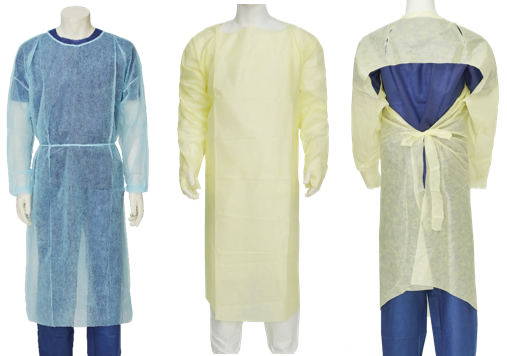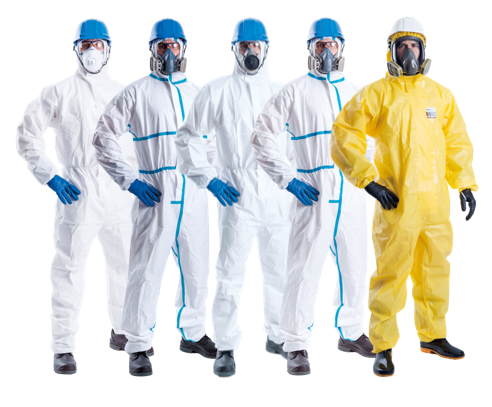In the world crisis of COVID-19, we noticed frontline operators were equipped with either gown, coverall or both during their infection control processes such as clinical assessment, safety screening or rapid diagnostic tests. As an action-led protective clothing manufacturer powered by communications, during the guiding process for users to select appropriate Personal Protective Equipment (PPE), we found out people might not understand the difference between Gown and Coverall that well. These two can be further differentiated according to global regulations, product designs and protected area coverage.
US Standard and EU Standard Comparison Chart
During the Covid-19 period, as it is an infectious human-to-human transmission disease, most inquiries were specified to AAMI PB 70 or EN 13795 for Gown, and EN ISO 13688 for Coverall with EN 14126 certification against infective agents. These criteria are classifications based on US Standard and EU Standard which listed as the following:

Table 1: US Standard and EU Standard for Gown and Coverall
Specifications for Gown

What is a Gown?
A gown is defined as the protective apparel specifically used to protect healthcare personnel and patients from the transfer of microorganisms and body fluids in patient isolation situations.
A gown is intended to prevent frontal contamination only, thus the risk evaluation had to be considered when choosing a gown for infection control. It provides partial neck-to-knee protection and often has openings in the back region due to comfort concern. Ties on the abdomen are a common feature, however, if they are not properly tied or sometimes not tied at all, it has been determined that this can cause other hazards.
Please note that both AAMI PB 70 Standard and EN 13795 Standard performance tests on gown are for fabric and seam only. The test criteria requires only essential parts, including sleeves, chest and seam areas of the joint, without a whole garment test worn by a real person.
| US Standard
AAMI PB70 AAMI PB70 provides basic tests to evaluate the barrier effectiveness of gown. Based on the results of these standardized tests, 4 barrier performance levels are specified with the lowest level of protection being Level 1, and the highest level of protection being Level 4.
Minimal level of fluid barrier protection
Low level of fluid barrier protection
Moderate level of fluid barrier protection
Highest level of fluid and viral barrier protection |
EU Standard
EN 13795 EN13795 provides guidelines on the characteristics of gown for protection against microorganism transmission during invasive surgical procedures. There are 2 classifications, namely Standard Performance and High Performance.
Non-reinforced or fabric-reinforced for low to medium risk of exposure
Poly-reinforced for high risk of exposure |
Specifications for Coverall

What is a Coverall?
A coverall is the protective clothing designed to protect either the wearer’s body or other items of clothing from environmental hazards. Also, special coverall may protect the working environment from pollution and/or infection from the wearer.
Coverall is designed to protect the entire body. This enables 360 degrees of protection for frontline operators during infection control, which is particularly important when you are unsure about directions of potential environmental hazards.
For the performance tests, coverall is required to pass fabric, seam and whole garment tests. It is normally being tested by a real person doing precise movements in a test chamber to complete a liquid penetration test or particulate inward leakage examination, which is more realistic in daily scenarios.
| US Standard
No standard nor classification for coverall Levels ABCD are generally mistaken as coverall standard. They are in fact classification of the environment according to possible hazards.
Confined areas where hazards have not been fully identified, and require maximal skin, eye, and respiratory protection
Atmosphere contains less than 19.5% oxygen, require maximal respiratory protection. Lower level skin hazard may be present
Hazards have been identified and will not be absorbed by or adversely affect exposed skin
No or very low potential hazards |
EU Standard
EN 13688 It specifies requirements for ergonomics, safety,
|
EU Standard is the most recognized standard for coverall in worldwide. During disease infection control, you may focus on additional EN 14126 certification on fabric against infective agents, which is essential to protect frontline operators from biological hazards. A suffix “-B” will be added after wording “Type” to indicate it is “Biohazard protected”.
Conclusion
Owing to a lack of common criteria or study results it is hard to say when to wear a gown or coverall. The explanation of why no studies have been performed to determine gown versus coverall effectiveness is because they are entirely different items and are used in different fields.
Unless you are confident that the risk contact comes from the front chest and arms, a gown that meets performance requirements may be good enough and can therefore still be used in healthcare facilities. But when COVID-19 or other unknown aerosol transmissible diseases are encountered, we recommend that an EN 14126 certified coverall is more appropriate for frontline operators than a gown.
There are 3 solid reasons:
- Coverall provides 360 degrees of protection from head to ankle for the whole body including the back region.
- Coverall is required to pass both fabric and whole garment tests, and a real person is used to simulate daily scenarios that are more in line with the actual situation of use.
- Coverall with EN 14126 certification will protect you from infective agents. The test includes protection against blood/fluids, blood-borne pathogens, aerosol, dry and wet microbial penetration.
However, it is always a smart idea to enhance personal protection for occupational safety. If there is a need for combination of other PPE, please seek final professional advice from your safety managers in consideration of your workplace risks.
- ULTITEC Played Significant Role During COVID-19
- Understanding EN 14126:2003 for Battle Against COVID-19
- What Protective Clothing Is Appropriate for Novel Coronavirus (COVID-19) Disease Control ?
- What should you understand about CE test standard for protective clothing?
- How Well Do You Understand EN 14126:2003? Protection Against Biological Agents in Workplace
- COVID-19: What Can You Do to Protect Yourself
- EN 14126 Certified Protective Clothing to Protect Against COVID-19

